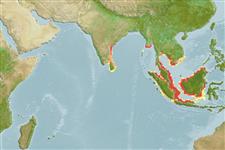Common names from other countries
Teleostei (teleosts) >
Clupeiformes (Herrings) >
Engraulidae (Anchovies) > Engraulinae
Etymology: Stolephorus: Greek, stole, -es = garment + Greek, pherein = to carry (Ref. 45335).
Environment: milieu / climate zone / depth range / distribution range
Ecology
Marine; brackish; pelagic-neritic; amphidromous (Ref. 51243); depth range 0 - 50 m (Ref. 189). Tropical; 16°N - 7°S, 79°E - 118°E (Ref. 189)
Indo-Pacific: Eastern Indian Ocean (Waltair and Kakinada, if the subspecies bengalensis is truly this species) and western Pacific (Gulf of Thailand, Singapore, Sumatra, Sarawak).
Size / Weight / Age
Maturity: Lm ? range ? - ? cm
Max length : 10.0 cm NG male/unsexed; (Ref. 27550)
Dorsal spines (total): 0; Anal spines: 0; Anal soft rays: 18 - 19. Belly with 6 or 7 (rarely 8) small needle-like pre-pelvic scutes; a small pre-dorsal spine and another spine on the pelvic scute. Maxilla pointed, reaching to or beyond hind border of pre-operculum, the latter concave, indented near maxilla tip. Few small teeth on upper edge of hyoid bones in some specimens. A double pigment line on back behind dorsal fin.
A schooling species occurring in coastal waters, but perhaps able to tolerate lowered salinities (e.g. mouth of Indragiri River, Indonesia). Marketed fresh or dried (Ref. 27550).
Life cycle and mating behavior
Maturities | Reproduction | Spawnings | Egg(s) | Fecundities | Larvae
Whitehead, P.J.P., G.J. Nelson and T. Wongratana, 1988. FAO Species Catalogue. Vol. 7. Clupeoid fishes of the world (Suborder Clupeoidei). An annotated and illustrated catalogue of the herrings, sardines, pilchards, sprats, shads, anchovies and wolf-herrings. FAO Fish. Synop. 125(7/2):305-579. Rome: FAO. (Ref. 189)
IUCN Red List Status (Ref. 130435)
CITES (Ref. 128078)
Not Evaluated
Threat to humans
Harmless
Human uses
Fisheries: commercial
Tools
Special reports
Download XML
Internet sources
Estimates based on models
Preferred temperature (Ref.
115969): 28.2 - 29.3, mean 28.8 (based on 468 cells).
Phylogenetic diversity index (Ref.
82804): PD
50 = 0.5000 [Uniqueness, from 0.5 = low to 2.0 = high].
Bayesian length-weight: a=0.00537 (0.00253 - 0.01141), b=3.13 (2.96 - 3.30), in cm Total Length, based on LWR estimates for this (Sub)family-body shape (Ref.
93245).
Trophic level (Ref.
69278): 3.3 ±0.4 se; based on size and trophs of closest relatives
Resilience (Ref.
120179): High, minimum population doubling time less than 15 months (Preliminary K or Fecundity.).
Fishing Vulnerability (Ref.
59153): Low vulnerability (10 of 100).
